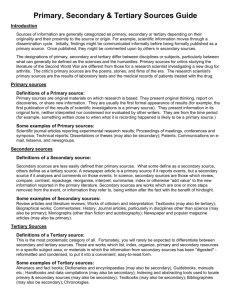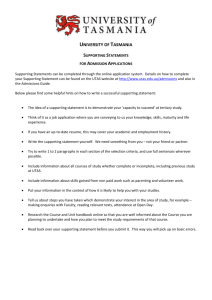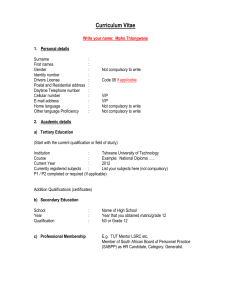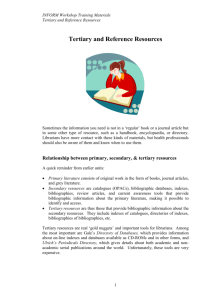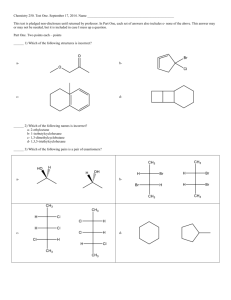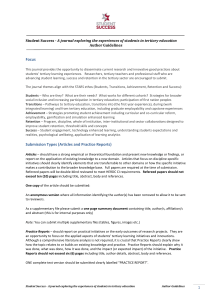PRIMARY, SECONDARY & TERTIARY SOURCES Guide
advertisement
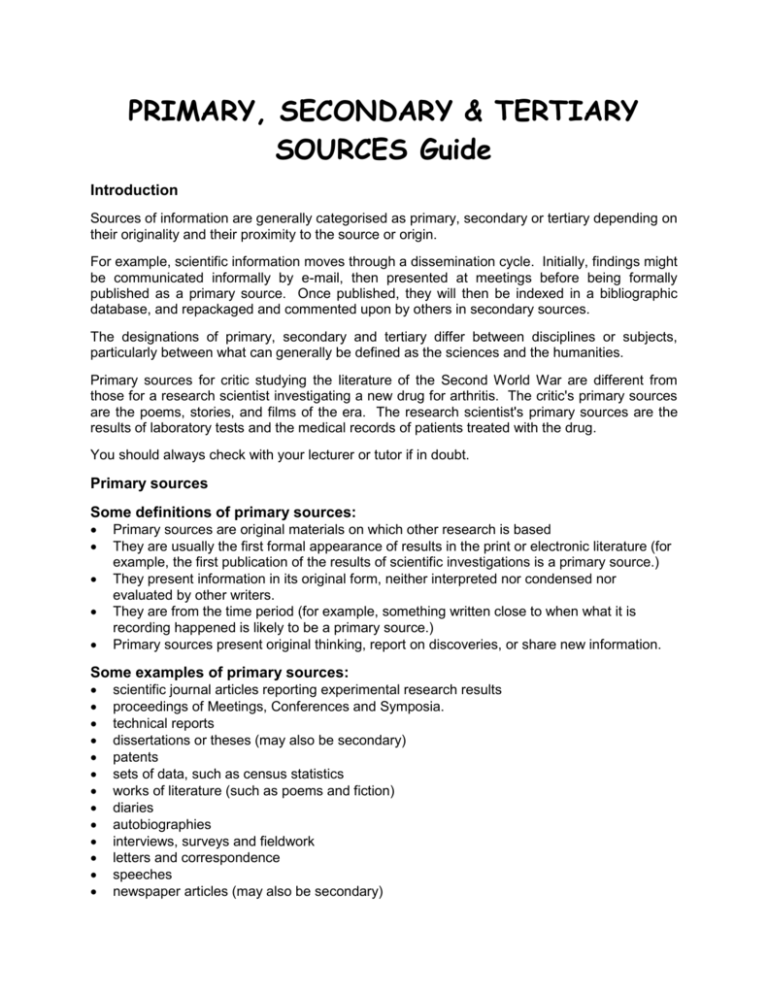
PRIMARY, SECONDARY & TERTIARY SOURCES Guide Introduction Sources of information are generally categorised as primary, secondary or tertiary depending on their originality and their proximity to the source or origin. For example, scientific information moves through a dissemination cycle. Initially, findings might be communicated informally by e-mail, then presented at meetings before being formally published as a primary source. Once published, they will then be indexed in a bibliographic database, and repackaged and commented upon by others in secondary sources. The designations of primary, secondary and tertiary differ between disciplines or subjects, particularly between what can generally be defined as the sciences and the humanities. Primary sources for critic studying the literature of the Second World War are different from those for a research scientist investigating a new drug for arthritis. The critic's primary sources are the poems, stories, and films of the era. The research scientist's primary sources are the results of laboratory tests and the medical records of patients treated with the drug. You should always check with your lecturer or tutor if in doubt. Primary sources Some definitions of primary sources: Primary sources are original materials on which other research is based They are usually the first formal appearance of results in the print or electronic literature (for example, the first publication of the results of scientific investigations is a primary source.) They present information in its original form, neither interpreted nor condensed nor evaluated by other writers. They are from the time period (for example, something written close to when what it is recording happened is likely to be a primary source.) Primary sources present original thinking, report on discoveries, or share new information. Some examples of primary sources: scientific journal articles reporting experimental research results proceedings of Meetings, Conferences and Symposia. technical reports dissertations or theses (may also be secondary) patents sets of data, such as census statistics works of literature (such as poems and fiction) diaries autobiographies interviews, surveys and fieldwork letters and correspondence speeches newspaper articles (may also be secondary) 2 government documents photographs and works of art original documents (such as birth certificate or trial transcripts) Internet communications on e-mail, listservs, and newsgroups Secondary Sources Some Definitions of Secondary Sources Secondary sources are less easily defined than primary sources. What some define as a secondary source, others define as a tertiary source. Nor is it always easy to distinguish primary from secondary sources. A newspaper article is a primary source if it reports events, but a secondary source if it analyses and comments on those events. In science, secondary sources are those which simplify the process of finding and evaluating the primary literature. They tend to be works, which repackage, reorganise, reinterpret, summarise, index or otherwise “add value” to the new information reported in the primary literature. More generally, secondary sources describe, interpret, analyse and evaluate the primary sources comment on and discuss the evidence provided by primary sources are works, which are one or more steps removed from the event, or information they refer to, being written after the fact with the benefit of hindsight. Some examples of secondary sources: bibliographies (may also be tertiary) biographical works commentaries dictionaries and encyclopedias (may also be tertiary) dissertations or theses (more usually primary) handbooks and data compilations (may also be tertiary) history indexing and abstracting tools used to locate primary & secondary sources (may also be tertiary) journal articles, particularly in disciplines other than science (may also be primary) monographs (other than fiction and autobiography) newspaper and popular magazine articles (may also be primary) review articles and literature reviews textbooks (may also be tertiary) treatises works of criticism and interpretation Tertiary Sources This is the most problematic category of all. Fortunately, you will rarely be expected to differentiate between secondary and tertiary sources. 3 Some Definitions of Tertiary Sources works which list primary and secondary resources in a specific subject area works, which index, organise and compile citations to, and show you how to use, secondary (and sometimes primary) sources. materials in which the information from secondary sources has been "digested" reformatted and condensed, to put it into a convenient, easy-to-read form. Sources which are once removed in time from secondary sources Some examples of tertiary sources: almanacs and fact books bibliographies (may also be secondary) chronologies dictionaries and encyclopedias (may also be secondary) directories guidebooks, manuals etc handbooks and data compilations (may also be secondary) indexing and abstracting tools used to locate primary & secondary sources (may also be secondary) textbooks (may also be secondary) Some comparative examples of primary, secondary and tertiary sources DISCIPLINE ART PRIMARY Original artwork ENGINEERING Patent HISTORY Explorer’s diary LITERATURE SCIENCE Poem Journal article reporting original coral research THEATRE Video of a performance PSYCHOLOGY Notes taken by a clinical psychologist SECONDARY Article critiquing the work Derwent Patents Index Biography of the explorer Treatise on poetry 1. Biological Abstracts 2. Review recent of coral research Review of the performance Monograph on the condition For further information see: Literature of the Sciences http://www.library.jcu.edu.au/pd/lbawgs/litsci.html and Yale University Library - Primary Sources Research http://www.library.yale.edu/ref/err/primsrcs.htm TERTIARY Art Index Guide to using patent literature APAIS MLA 1. 2. Biological Abstracts Chronology of the play Dictionary of psychology

